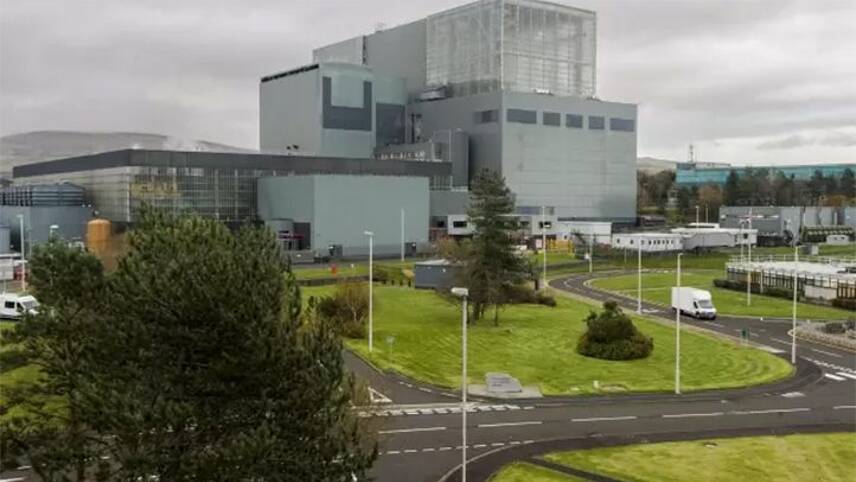Register for free and continue reading
Join our growing army of changemakers and get unlimited access to our premium content

Image: EDF
The plant, on the Firth of Clyde Coast, is operated by EDF and represents one-eighth of the UK’s current nuclear generation capacity of 7.9GW. It came online in 1976 and was originally intended to have a 25-year working lifespan, but repairs enabled a 21-year extension to operations.
One of the station’s two reactors came offline in November 2021. The other will be shut down today.
EDF said in a statement that it has supported staff to move to other sites, to remain employed at the site during the refuelling and decommissioning process, or to retire.
“The contribution Hunterston B power station has made to this country cannot be underestimated,” said EDF’s station director for Hunterston B, Paul Forrest.
“As well as providing stable, well-paid employment for thousands of people in the North Ayrshire area, it has produced almost 300TWh of zero-carbon electricity, enough to power every home in Scotland for 31 years.”
Nuclear gap
The UK currently generates about 20% of its electricity from nuclear. However, this proportion is set to fall to 16% this month with the closure of Hunterston B – and will likely fall further in the coming years, as almost half of the UK’s nuclear capacity is set to be retired by 2025. Hinkley Point B, Heysham I and Hartlepool nuclear power stations are all scheduled to retire by the end of 2024, representing more than 4GW of nominal generating capacity. Another two large facilities are planning to come offline by 2030.
At present, the only large-scale replacement plants in the pipeline are the 3.2GW array at Hinkley Point C and 2.9GW array at Wylfa Newydd, also known as Wylfa B. Both projects have been plagued by delays due to slow decision-making from Ministers and investors. Gas peaking is poised to be the stop-gap solution for keeping supply up in light of this trend.
Trade Body the Nuclear Industry Association (NIA) is marking Hunterston B’s closure by making fresh calls for Ministers in Whitehall and Holyrood to set clear and ambitious long-term plans for closing the impending nuclear gap without turning to gas.
At present, the central UK Government’s flagship nuclear commitment is £1.7bn to bring at least one large-scale nuclear project to a final investment decision by 2030. There is a further £120m pledge to the Future Nuclear Enabling Fund to provide targeted support towards further nuclear projects as part of the Net Zero Strategy.
“As the current energy crisis demonstrates, the cost of the electricity we rely on is higher, causes pollution and leaves us reliant on burning imported fossil fuels, without nuclear,” said the NIA’s chief executive Tom Greatrex.
“That’s why we need new nuclear – to get to net-zero and provide the reliable, secure and clean power to live our lives.”
Gas prices hit £4 per therm at the end of 2021, up from 50p per therm in November 2020, with most of this increase having taken place since August. As gas accounts for some 40% of electricity generation in the UK at present, this global price hike has affected UK electricity as well as gas.
While the NIA is, of course, keen to promote nuclear as the solution, other groups and academics have said the energy price crisis could have been avoided if the UK had moved sooner and more boldly on renewables.
Commenting on the Hunterston B closure, WWF Scotland’s director Land Banks said: “The repeated failure to solve the problem of hundreds of cracks in the graphite bricks surrounding the reactor core means the closure of Hunterson B was inevitable.
“Thankfully, Scotland has massively grown its renewable power generating capacity – which means we’ll no longer need the electricity from this increasingly unreliable nuclear power plant. As the expensive and hazardous job of cleaning up the radioactive legacy Hunterston leaves in its wake now begins, Scotland must press on with plans to harness more clean, renewable energy.”
Scotland is notably targeting net-zero by 2045 – five years ahead of the UK as a whole. It had been hoping to generate enough renewable electricity to equate to 100% of national electricity consumption by 2020, but narrowly missed this milestone, recording a 98.6% proportion.
Sarah George


It’s Hinkley Point C, not Hinkley Point Sea, albeit is by the sea.
Yes, lovely clean renewable energy, but it depends on nature.
And nature is a precocious and unreliable animal.
The desirability of nuclear power lies in its dependability, cleanliness and longevity.
Nothing is perfect, but nuclear power is pretty good.
Richard Phillips